By Sue Hyde, Director of the Task Force’s National Conference on LGBT Equality: Creating Change
The first cases of mysterious illnesses affecting gay men were reported by 1981. Kaposi’s sarcoma, a relatively benign form of cancer in older people, aggressively struck young gay men in New York City.
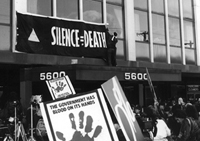
In both New York and California at about the same time, cases of a rare and persistent lung infection called Pneumocystis carinii pneumonia were also reported. As more and more data accumulated, GRID (gay-related immune deficiency), AID (acquired immunodeficiency disease), “gay cancer” or “community-acquired immune dysfunction,” changed names and changed shape. Bruce Voeller, former executive director of the National Gay Task Force, would conduct early research establishing that condoms prevent the spread of AIDS, and he established the use of the term Acquired Immune Deficiency Syndrome, rather than the inaccurate and stigmatizing “Gay Related Immune Deficiency” to describe this syndrome.
Originally thought to be confined to gay men, cases began to be reported in hemophiliacs, Haitians and women. Alarms sounded all over the country, but especially for gay men and those who cared about them. What seemed to be a minor medical mystery morphed into the most profound public health catastrophe to strike gay communities in the United States. The catastrophe continues, hitting young gay and bisexual men of color especially hard.
In 1982, Virginia Apuzzo, then executive director of the National Gay Task Force in New York City, saw big trouble brewing. And a toxic brew it turned out to be: a sexually transmitted, initially untreatable and fatal disease primarily affecting gay and bisexual men mixed with deep-seated homophobia and sex phobia.
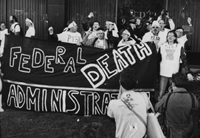
Despite launch of local first-responder organizations like the Gay Men’s Health Crisis (GMHC) in New York City, Apuzzo believed that meeting the health crisis at scale required resources from the federal government. In 1983, she brought Jeff Levi on to the Task Force staff; Levi was the first AIDS lobbyist from a gay organization to work the halls of Congress and federal agencies.
Apuzzo and Levi crafted a plan to lobby federal decision makers and to work with other organizations to build support for federal intervention, including funding for care of people with AIDS and AIDS prevention education. They met with limited success, but Apuzzo testified at a 1983 congressional hearing to excoriate the Reagan administration for the lack of federal response to AIDS. In 1984, Apuzzo and others raised funds to launch the AIDS Action Council, the country’s first advocacy organization focused on public policy and funding to meet the crisis. Apuzzo took it personally, too; Task Force organizational lore has it that Apuzzo counseled her staff on safe-sex practices.
Jeff Levi became the Task Force executive director in 1985. The organization changed its name to the National Gay and Lesbian Task Force and relocated its office to Washington, D.C. Levi devoted the next four years to advocating for effective federal policy and funding and fighting off the homophobia-laden legislative initiatives coming from the likes of Sen. Jesse Helms (R-N.C.).
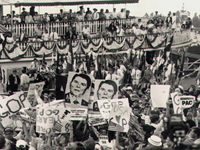
In order to move the good mountains and stop the bad, Levi founded a new coalition, National Organizations Responding to AIDS (NORA). The NORA coalition included public health organizations, which in turn played a key role to define the AIDS epidemic as a public health emergency. At the same time, NORA and other groups drew political and public attention away from AIDS as an epidemic in gay and bi communities, the “de-gaying of AIDS,” as it became known. This was a shrewd political and messaging maneuver because it allowed political leaders to push forward AIDS policy and funding as wise public health initiatives for the public good.
For example, the CDC convened a 1987 policy-setting conference on mandatory testing, which was widely regarded as an unacceptable counterproductive strategy that would drive people away from voluntary testing for HIV.
Levi, along with then Task Force media director Urvashi Vaid and other advocates, collected statements from public health experts on the deleterious impact of mandatory testing. Via a round-the-clock press operation at the CDC conference, they featured prominent public health officials, scientists, doctors, lawyers and activists who repeated the anti-mandatory testing messages. When the conference was over, the media coverage showed that the public health community overwhelmingly supported voluntary testing and mandatory testing was never instituted.
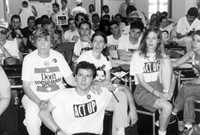
Such victories, though, were also punctuated by vicious attacks fueled by homophobia and irrational fear of HIV transmission. Of particular importance, just days after the 1987 March on Washington for Lesbian and Gay Rights, Helms succeeded in passing an amendment to an AIDS education bill that outlawed federal funds for AIDS education that “promote or encourage, directly or indirectly, homosexual activities.”
In other words, AIDS education materials supported by federal funds would be stripped of any culturally competent language directed to gay and bi men about how to prevent the spread of AIDS: condom use, information about risks associated with anal and oral sex, and advice about negotiating safe sex with sexual partners. The Helms amendment defined federally funded AIDS education material from 1987 to 1992 when it was struck down in court. No one knows how many people were needlessly infected because of the Helms amendment, but surely there were thousands.
Levi and his AIDS lobbyist colleagues scored two major victories in 1990. First, enactment of the Ryan White CARE Act, which is the largest federally funded program for people living with HIV/AIDS. Ryan White provides access to health care for low-income, uninsured and under-insured people with AIDS and their families. It has improved life for hundreds of thousands of people and continues to do so today.
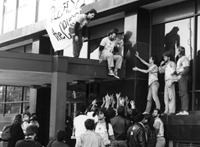
Second, enactment of the Americans with Disabilities Act (ADA), which included people living with HIV/AIDS and prohibits discrimination against them in a range of activities, including employment, public accommodations and public transportation.
Finally after years of AIDS-related discrimination, people with AIDS had legal recourse if they were fired or denied employment, denied access to public accommodations and public transportation simply because of their HIV/AIDS diagnosis. There was also a major setback in 1990 when the U.S. government issued a ban for persons with HIV/AIDS to enter the United States, a ban that prevented the International AIDS Conference from being held in the U.S. until 2012, following the lifting of the ban by the Obama administration.
Even with progress in public policies and funding to fight the AIDS epidemic, anger and frustration boiled in the LGBT communities. Inspired by a fiery speech in March 1987 from activist and author Larry Kramer, hundreds of people founded and formed ACT UP, AIDS Coalition to Unleash Power. Unleash power it did. ACT UP staged spectacular demonstrations and protests, targeting big pharmaceutical companies on Wall Street, Catholic Church leadership, the U.S. government from the president to the federal agencies in charge of drug trials, AIDS education and funding. ACT UP chapters sprang up in cities all over the world to demand action on AIDS.
The Task Force, perceived by some to be only an inside-the-Beltway player, collaborated with ACT UP activists to stage a number of demonstrations, especially in Washington, D.C. On Oct. 11, 1988, thousands of demonstrators gathered to seize control of the Food and Drug Administration (FDA), demanding swifter and more efficient testing and trials of AIDS medications.
Urvashi Vaid, then communications director, and I as an organizer, were in the leadership of the media operation and the action planning committee respectively. The FDA shut down for the day, but demonstrators failed to gain access to the building in which they had vowed to take over the desks to move and approve life-saving medications then stuck in a bureaucratic logjam.
The message sent was received at the FDA. Immediately after the FDA protest, Jeff Levi and other AIDS advocates met with FDA officials to secure drastically shortened time frames for testing and releasing life saving drugs for people with AIDS. Levi had great respect for the outside/inside tactics and strategies made possible by ACT UP and other groups because the heat of direct action opened doors for advocates so much more quickly.
The Republican National Convention convened in New Orleans in August 1988. Task Force staff, ACT UP organizers and staff from the Human Rights Campaign Fund hit the streets to protest the Republican leadership’s hostility and indifference to what was then over 40,000 deaths from AIDS. At a speakout on homophobia, members of Young Americans for Freedom arrived with signs that read “AIDS Is the Cure.” The AIDS-related protests drew catcalls, shoves and spittle; even death threats from Republican convention goers.
George H.W. Bush became the next president of the United States. At a conference sponsored by the National Leadership Coalition on AIDS, Bush on March 30, 1990 delivered his first policy speech on AIDS; Urvashi Vaid disrupted it by holding up a sign that read, “Talk Is Cheap, AIDS Funding Is Not.” She was removed from the audience by police, but the New York Times covered the story with a front page photo of Vaid’s sign.
The Task Force’s annual Creating Change Conference has been a hotbed of AIDS activism and advocacy. At the 2009 Creating Change Conference, Marjorie Hill, president and CEO of GMHC, calls for action from attendees to secure the first-ever National Strategy on AIDS, put into place by the Obama administration in 2010:
As early as 1989, plenary speaker Vito Russo stirred attendees at the Creating Change Conference held in Alexandria Virginia to be out, loud and strong. Read more about Vito here. Through the years, Creating Change has offered a plethora of workshops, trainings, and plenary sessions all designed to keep LGBT people in the AIDS struggle.
With the advent of the National Strategy on AIDS and the Affordable Care Act adding to the Ryan White CARE Act, there is now a federal response to this epidemic that continues to sweep through our communities. The Task Force continues to push for improved federal policies and recently highlighted the impact of HIV on transgender people of color. Task Force staff and leaders are attending the 19th International AIDS Conference this year to again join with activists from around the globe to defeat AIDS.
Much has changed in the past 30 years, but this remains the same: only concerted action to stem the tide of AIDS will win this war.
All photos courtesy of Rex Wockner.
